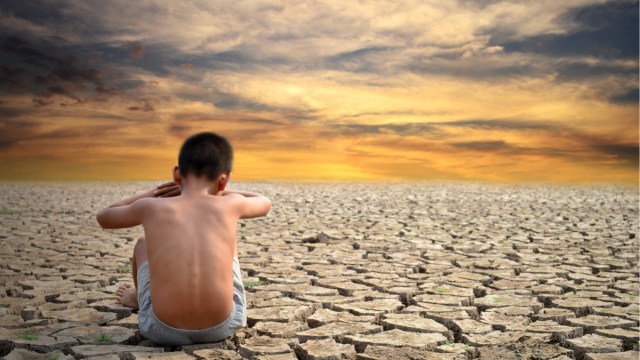The Perseid Meteor Shower Is Here, And Might Foretell Humanity’s Extinction

Doomsday prophesies have never once come to pass, but they’ve never had science on their side like this before.
Every year, the Earth completes an orbital revolution around the Sun, returning to the same relative position that it last occupied a year prior. On the night of August 12, 2019, the Perseid meteor shower will reach its peak, on practically the same date that it did the year prior, as the Earth makes its annual pass through the cometary debris stream that causes those spectacular light streaks across our skies.
The Perseids are very special among meteor showers for a number of reasons: they’re fast, they’re bright, and they’re extremely reliable. Year after year, even when there’s a full Moon present, the Perseids often put on a show unsurpassed by any other shower. Yet they’re also a reminder of the impending doom that’s headed our way: our eventual collision with an orbit-crossing comet or asteroid. If the body that created the Perseids ever collides with Earth, it will be a worse catastrophe than the extinction of the dinosaurs. Here’s the story everyone should know.
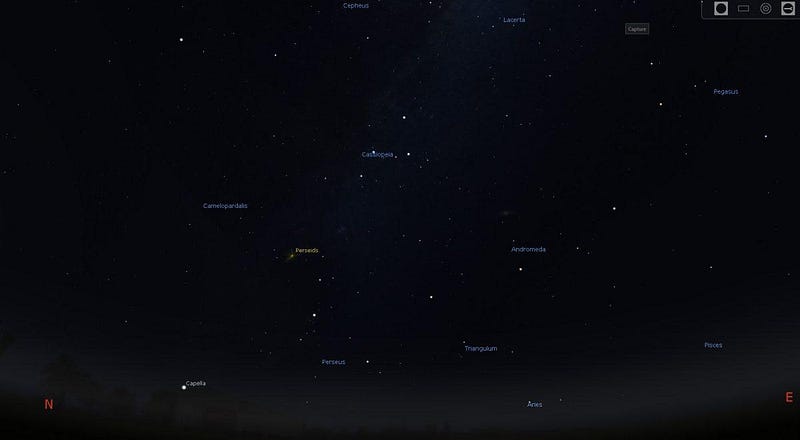
When we think about our Solar System, most people think about our Sun and the eight major planets: Mercury through Neptune. Perhaps many of us will also include the objects orbiting the planet, like moons and ring systems. Indeed, if you add all of these sources up, they are the largest and most massive components of our Solar System. All totaled, they account for approximately 99.96% of our Solar System’s mass.
But there’s much more than just the Sun and the planets. There are asteroids, which primarily orbit between Mars and Jupiter. There are Kuiper belt objects, which orbit in an extended disk beyond Neptune. There are centaurs, which orbit between asteroids and Kuiper belt objects: the hybrids of our Solar System. And there’s the Oort cloud, extending out for a light-year or more beyond the Kuiper belt. All totaled, there are likely more than a million objects populating these regions.
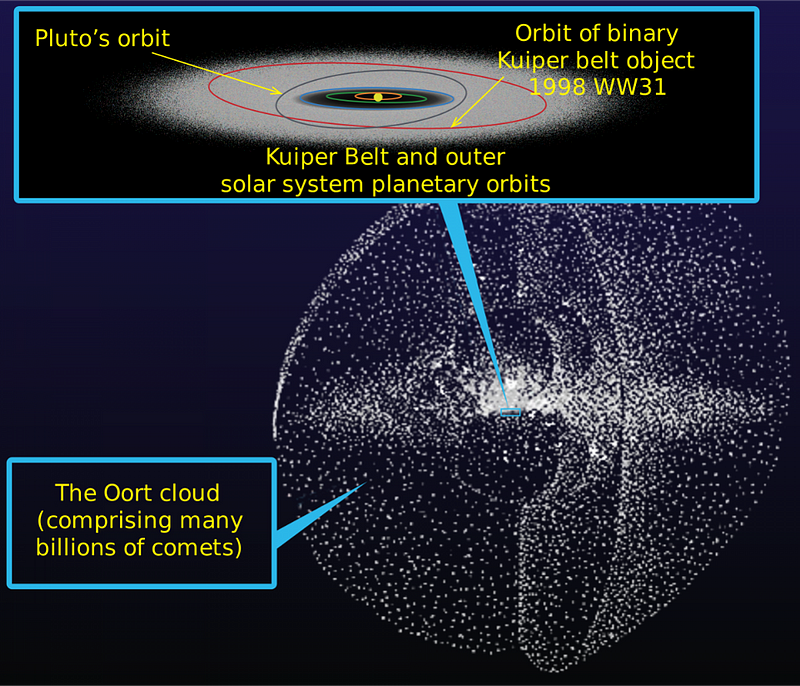
Any one of them, at any time, could receive a gravitational kick from any object in or near its vicinity. Some of them, when they pass close by another massive object, will get expelled from the Solar System entirely. Others will get hurled unceremoniously into the Sun. Still others, in perhaps the most common outcome, will have their orbits perturbed. When this occurs, there’s a chance that the object’s new trajectory will take it on an elliptical journey into the inner Solar System, where it has the opportunity to become a comet or comet-like object.
So long as there are volatile particles making up this object — including frozen ices like methane, nitrogen, carbon dioxide and water — then a close pass near the Sun will cause these particles to heat up and evaporate or sublimate. Inevitably, this object will offgas particles, and potentially have one or two tails as well.
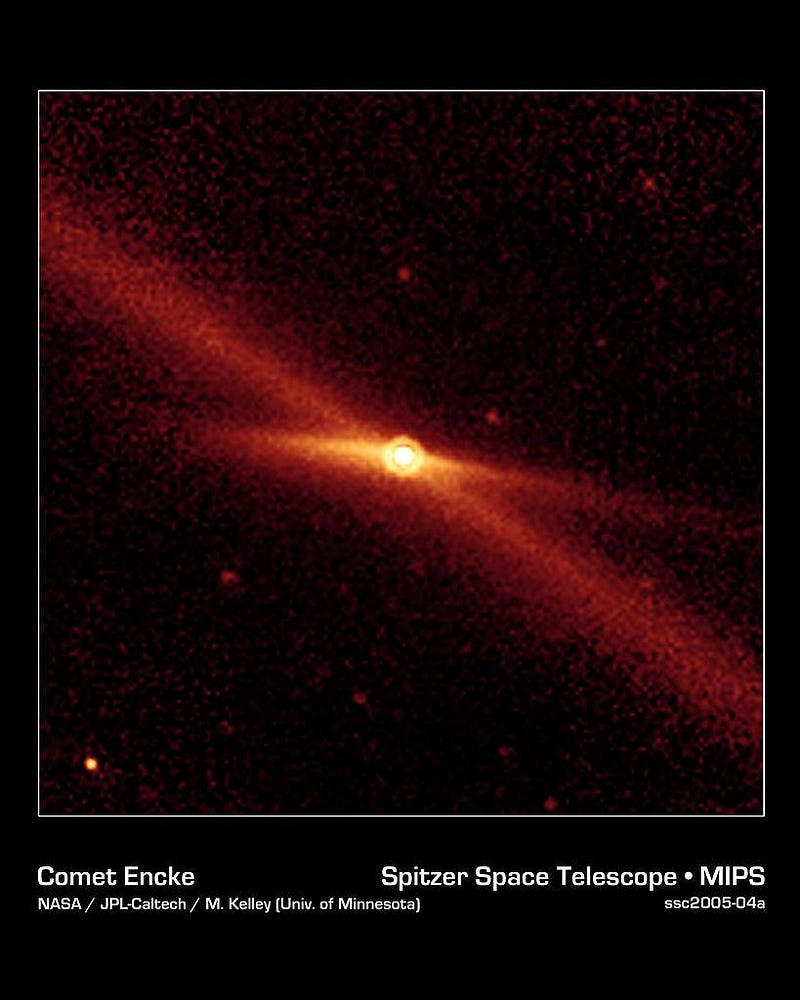
But the tails aren’t what cause the meteor shower at all. Those particles get blown off into an entirely different, more diffuse orbit than the object itself occupies. Comet tails may be spectacular sights as seen from Earth, but each one will have its own unique orbit around the Sun, and is unlikely to ever interact with the Earth.
On the other hand, the main object itself will have small chunks break off of it as it heats up, with some fragments orbiting ahead of the main body and others orbiting behind it. Over the course of many such orbits, these tiny bits that have been expelled from the parent body will grow populate the entire orbital path that the comet-like object follows. The debris, spread out over such a large, extended ring, forms the material that will create meteor showers whenever a planet passes through it.

It was a monumental discovery of the 19th century that linked periodic comets to meteor showers, and in the subsequent years and decades, we’ve identified a parent body for the majority of meteor showers here on Earth. If a meteor shower is visible on Earth, it’s because our planet passes through the debris stream created by a comet-like or asteroid-like body in the relatively recent history of the Solar System.
The Perseids are generally the most spectacular meteor shower of the year for a variety of reasons, including:
- the object that created the debris, Comet Swift-Tuttle, is massive and enormous, at 26 kilometers across,
- it has been creating the Perseids for thousands of years, giving it ample time to create a thick debris stream,
- and the meteors are very fast-moving, owing to Comet Swift-Tuttle’s highly eccentric, 133-year orbit.
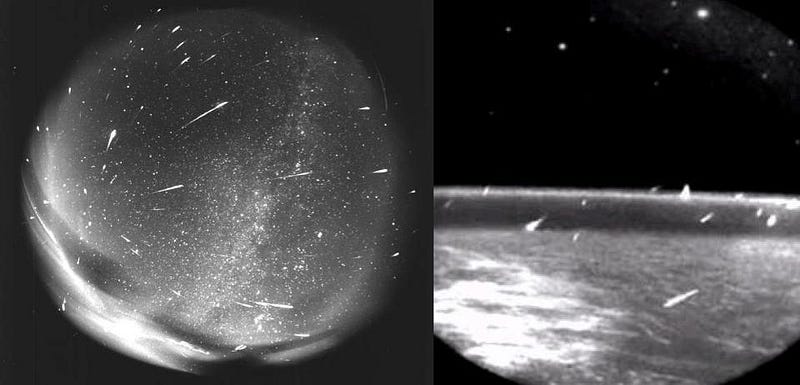
Put all of these factors together, and you wind up with a significant number of cometary fragments that strike the Earth at extremely high velocities: nearing 100 km/s. The event rate is extremely high at the peak of the Perseids, with meteors approaching or exceeding 100 per hour at maximum.
But what’s perhaps the most spectacular property of the Perseids is that the comet responsible for it, Swift-Tuttle (or 109P, if you’re an astronomer), is potentially the most dangerous object known to humanity. In December of 1992, this comet made its last close pass into the inner Solar System, and won’t be back until 2126. But every 133 years, when it crosses Earth’s orbit, there’s a small but finite chance that everything will be in the wrong place at the wrong time. If Swift-Tuttle were to collide with Earth, it would be game over for nearly all life on the planet.
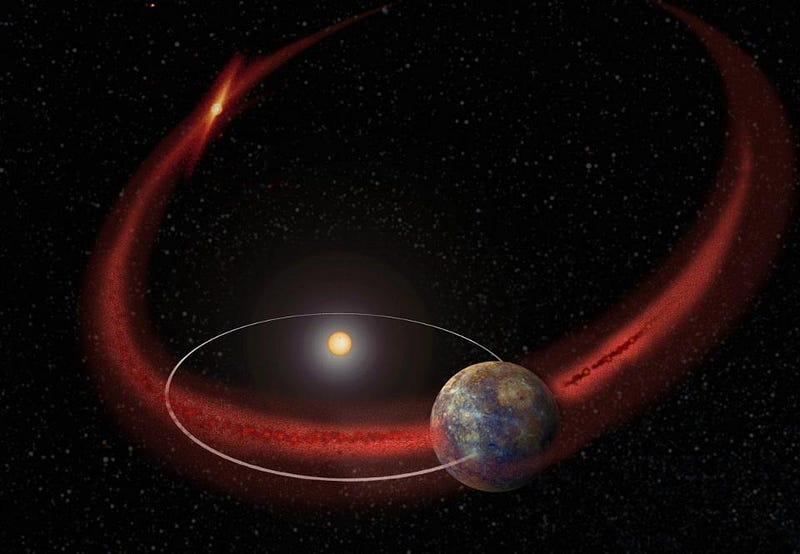
The object that struck Earth some 65 million years ago, leading to our most recent catastrophic mass extinction, was estimated to be an asteroid some 5-to-10 kilometers in diameter. Given the fact that Swift-Tuttle moves much faster that (about four times the speed of) most Earth-crossing asteroids and ought to be much more massive, we can expect an impact from Swift-Tuttle to impart 28 times as much energy as the dinosaur-killer from Earth’s ancient history.
If it struck the Earth, it would release more than one billion MegaTons of energy: the equivalent of approximately 20 million hydrogen bombs exploding all at once. According to Gerrit Verschuur, who wrote the definitive book on cometary and asteroid strikes, the comet that gives rise to the Perseids is, without a doubt, the single most dangerous object known to humanity.
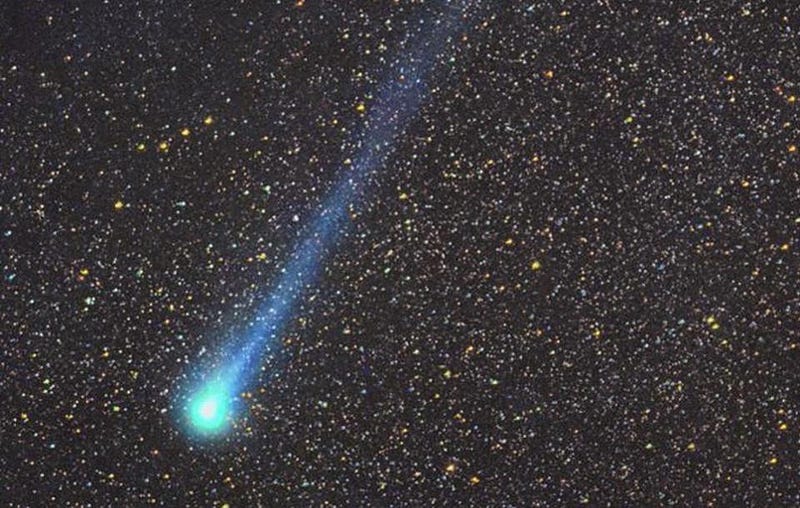
The good news is that, at least for the near-term future, we’re safe. Comet Swift-Tuttle’s orbit has been very well-studied and we can predict its trajectory quite accurately for at least the next few orbits. It’s absolutely an extremely hazardous body, as its perihelion takes it approximately 8,000,000 kilometers (5,000,000 miles) interior to Earth’s orbit.
Its next close approach, in 2126, will miss us by a large amount. The next six orbits after that won’t come near us, either, but in 3044, Comet Swift-Tuttle will pass within about 1,500,000 kilometers (less than 1,000,000 miles) of Earth. Its next 2,000 years of orbits have been mapped out very well, and the Earth is 100% safe from a collision with Swift-Tuttle over that time period. But in 4479, all of that could change.
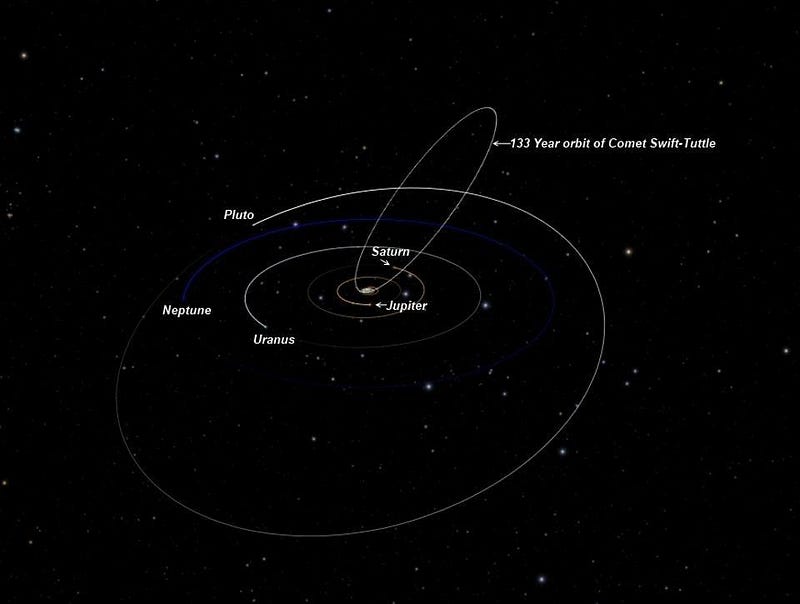
With every pass into and out of the Solar System, there’s a chance that Swift-Tuttle will pass close by one of the gas giant worlds, and such a gravitational tug could influence this comet’s orbit. Someday in the future, a slight push or pull from Jupiter or Neptune could alter Swift-Tuttle’s trajectory by a tiny amount: enough to put it on a collision course with Earth.
Astronomers who calculate the risk to Earth have taken a deep look at Swift-Tuttle’s projected path far into the future, and recognize that in 4479, there’s approximately an 0.0001% chance that Swift-Tuttle will impact the Earth. Without any gravitational interaction, Swift-Tuttle should miss us by around 133,000 km at its closest approach: about 11 Earth diameters. With a gravitational interaction, however, a collision becomes eminently possible.
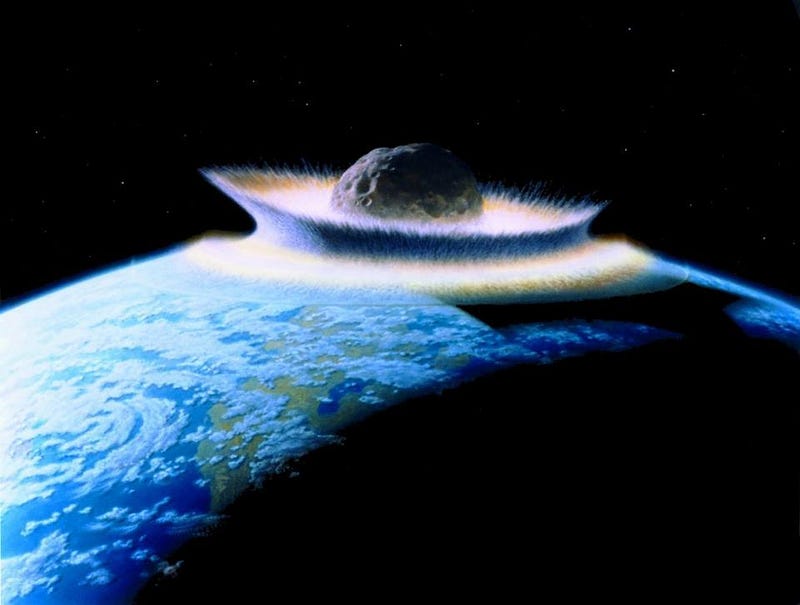
The Perseid meteor shower, even with a near-full Moon to contend with, should be one of the year’s most spectacular meteor showers. When you look up, scope out the northeast skies after sunset (from the northern hemisphere) and look for fast-moving streaks radiating away from just below the “W” in Cassiopeia. A few dozen bright streaks per hour, even in the worst-case scenario, should still await you.
But as you watch the skies, keep in mind that there’s an enormous comet responsible for this light show, and it returns every 133 years. In just a handful of orbits, it will come closer to Earth than any reasonable person should be comfortable with. Even if it’s not Swift-Tuttle, it’s only a matter of time before an object just like it comes for us, threatening the extinction of humanity and much more. We have a choice: we can let it come, or we can be ready. Extinction by comet strike is, for the first time ever, no longer an inevitability. We just have to invest in our own cosmic safety to avoid this catastrophic fate.
Ethan Siegel is the author of Beyond the Galaxy and Treknology. You can pre-order his third book, currently in development: the Encyclopaedia Cosmologica.





